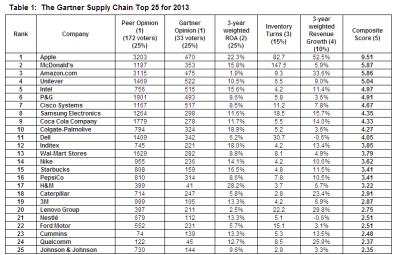Global research firm Gartner has released the findings from its ninth annual Supply Chain Top 25. The goal of the Supply Chain Top 25 research initiative is to raise awareness of the supply chain discipline and how it impacts business results.
“At the heart of the Supply Chain Top 25 is the notion of demand-driven leadership,” said Debra Hofman, managing vice president at Gartner. “We’ve been researching and writing about demand-driven practices since 2003, highlighting the journey companies are taking: from the old ‘push’ model of supply chain to one that integrates demand, supply and product into a value network that orchestrates a profitable response to ever-shifting changes in demand.”
Alongside some perennial leaders with new lessons to share, Gartner’s 2013 Supply Chain Top 25 offers three new companies, a growing group of industrials from which to learn, and two newcomers to the Top 5. The Top 5 includes three from last year — Apple, McDonald’s and Amazon — and two that are new to the Top 5 but have been rising steadily — Intel and Unilever. The three new companies joining the top 25 this year are Ford, Lenovo and Qualcomm.
Apple tops Gartner’s ranking for a record-breaking sixth year in a row, continuing to outpace everyone else by a wide margin on all five measures used. Apple was ranked No. 1 again by peer voters, capturing 75 per cent of the highest possible points a company can get across the voting pool. Nos. 2 and 3 switched places this year, with McDonald’s capturing the No. 2 slot and Amazon coming in at No. 3. This, however, was not reflected in the peer voters’ opinion. Amazon ranked a very close second behind Apple in the peer vote, almost completely closing the opinion gap from previous years and fast gaining on Apple’s voting position.

Gartner analysts highlighted three standout trends for supply chain leaders this year.
1. Performance
Many companies are working on building out the foundational components of an end-to-end supply chain across disparate businesses, focusing on improving core supply chain functions, and creating more common processes and systems across them. More-advanced companies describe a wide range of initiatives that build on the foundation, including end-to-end supply chain segmentation, simplification, cost-to-serve analytics, multi-tier visibility and supply network optimisation.
“What differentiates the top companies is where they are in the life cycle of these innovations,” said Stan Aronow, research director at Gartner. “The leaders have gone beyond the theory and are now deploying the capabilities that others are just starting to consider. In doing so, they are finding new and creative ways to use these capabilities, exploring synergies and opportunities they hadn’t necessarily anticipated in advance. Leaders are discovering that the combination of capabilities they are now implementing brings them to a new frontier of performance, and affords them an entirely new toolbox with which they can orchestrate the optimisation of their business and leap ahead of the competition.”
2. Smarter growth
Against a backdrop of slow growth, many companies might have been expected to retrench and slip back to focusing their supply chains solely and exclusively on delivering cost reductions and efficiency gains to corporate bottom lines. Instead, in 2013, leaders are embracing a new imperative for growth, realising they have to get smarter about how they do it.
“At leading companies in diverse industries, the supply chain organisation is no longer narrowly focused on driving efficiencies and cost cutting; it sees itself, and is seen by its CEO, as a growth enabler,” said Ms. Hofman. “Part of ‘getting smarter’ about growth is partnership across the business. Leading high-tech and consumer product companies, for instance, are approaching new markets with cross-functional teams that include sales, marketing, operations and IT to holistically design a synchronized entry strategy: starting with the customer and designing the right product, pricing, margin targets, service levels, and supply chain network design and tradeoffs that will all work together to achieve the goal.”
3. Talent
Acquiring, developing and retaining supply chain talent continues to be a major focus area for companies, and Gartner continues to publish extensive research in this area. Companies are investing time and resources in expanded university relationships, rotational programs, enhanced career progression planning specific to supply chain, multi-channel learning options, supply chain certification programs, supply chain leadership development, and others.
“Leading supply chain organisations are going beyond specific talent initiatives to look at the fundamentals of motivation in their supply chain teams,” said Mr Aronow. “For them it’s about engaging hearts, not just minds; it’s about igniting passion and excitement for the work, not just compliance. These organisations use terms such as wanting to be a ‘destination company,’ or an ‘employer of choice’ in supply chain. They’re finding ways to connect individual activity not only to their corporate goals, but to a larger aspirational goal.”





